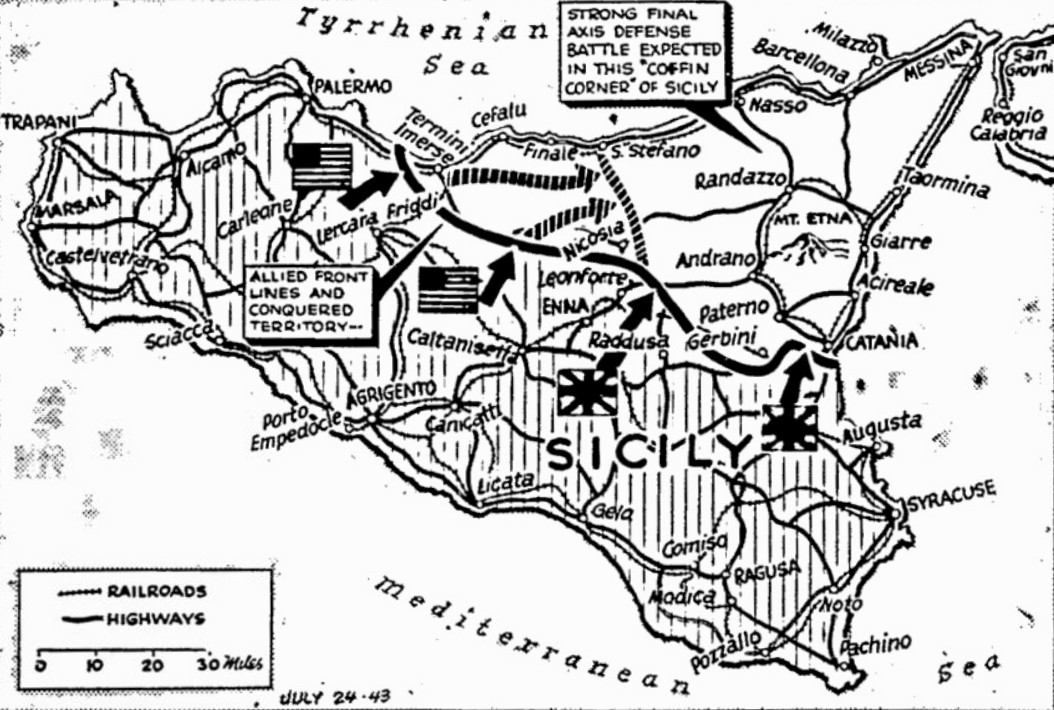The Pittsburgh Press (July 20, 1943)
YANKS DRIVE AHEAD OF CENTRAL SICILY
Allies report outbreaks in Italian ranks
Catania battle still rages, resistance crumbles elsewhere
By Virgil Pinkley, United Press staff writer
Bulletins!
London, England –
The Algiers radio reported tonight that fighting is going on in the suburbs of Catania.
London, England –
Algiers radio reported tonight that American military experts have said that Gen. Dwight D. Eisenhower, Allied Commander-in-Chief, is ready to invade Italy “as soon as it is considered advisable.”
Allied HQ, North Africa –
The see-saw battle for Catania raged more bitterly than ever today, with the British 8th Army tightening a stranglehold on the east coast port, while an Allied communiqué reported signs of mutiny among Italian troops elsewhere in Sicily.
The U.S. 7th Army surged northward through the middle of Sicily, closing in on Enna and seeking to cut the island in two. Reports indicated that opposition in that sector was crumbling to little more than token resistance.
Nazi paratroops attack
But there was furious fighting at Catania, where attack and counterattack followed in rapid succession and the Germans threw paratroops into action as infantry in their desperate efforts to hold off the forces of Gen. Sir Bernard L. Montgomery at Catania and westward around the Gerbini Airdrome.
Gen. Giulio Cesare Gotti Porcinari, commanding the 54th Naples Division, was captured – the fourth Italian divisional commander to be taken prisoner.
The 8th Army had established a number of bridgeheads north of the Simeto River, which runs just south of Catania, and have held them against many fierce thrusts by Nazi tanks.
Gerbini airdromes threatened
The line held by Gen. Montgomery’s men starts on the sea and runs inland about 22 miles to Ramacca, passing south of the Gerbini Airdrome area which had been reported gravely threatened by the Allied troops.
The Americans who took Caltanissetta were pushing on northward in mid-Sicily toward the important road junction of Enna and had reached the Caterina area, which lies west of Enna.
Thus, the Canadians were hacking forward directly toward Enna while the American attack had swung slightly to the west in the Caterina sector, where roads lead to the north coast without passing through Enna, main Axis base in central Sicily. This suggested that the Americans might push on some 30 miles toward Termini Imerese on the north coast without waiting for the fall of Enna.
Allied casualties light
The Canadians smashed back several enemy counterblows. Casualties among the Allied troops in this sector and most other areas were comparatively light.
The Canadians, approaching Enna from the southeast, ran into stiffening resistance by reformed elements of the German 15th Panzer Division and were slowed down somewhat. The Allied pincer is about 10 miles from Enna.
On the western end of the line, where the Americans took Agrigento and Porto Empedocle, the Allied line was being extended along the coast and is now approximately 100 miles long on the south coast.
It was in this sector that opposition seemed least and many Italian units – largely Sicilian – surrendered en masse.
British military observers in London said that the speed of the American advance threatened to deal a knockout blew to the whole Italian resistance in central Sicily. Radio Algiers said both U.S. and Canadian troops have reached Enna.
Catania was already in flames from repeated bombings, the latest Sunday night, and naval bombardments. 8th Army patrols stabbed at the enemy defenses while gathering strength for an all-out assault to capture the city, Gen. Dwight D. Eisenhower’s communiqué said.
Radio London said British troops at last reports were only 2.5 miles from Catania with the battle for possession of the city now raging. A Vichy broadcast, quoted by Radio Algiers, said the British succeeded ion piercing the German lines south of Catania at heavy cost, while Berlin reported British attacks from the south and through the mountains from the west.
Yanks drive two ways
The communiqué said the Americans were driving both northward toward central Sicily and northwestward along the south coast toward Sciacca.
The communiqué said:
They report little resistance in the west, where hundreds of the enemy have been giving themselves up. There are many indications of mutiny by Italian troops commanded by German officers.
